Helmets of the First World War.
 Bashny.Net
Bashny.Net
Anyone who does not remember the past are doomed to repeat it
Good day, dear yapovtsy. Today I want to talk about helmets. It is difficult to imagine a modern soldier without this most helmets. I will not delve into history and recall the helmets of ancient warriors, and want to talk about helmets First World War, because in fact if helmets are almost departed into oblivion came back again and become an integral part of the equipment of a soldier.
You know, I've been thinking of the country with which to start? in most countries by the beginning of World War II were sometimes brilliant ideas. Therefore, I will first tell you about the allies, and then on the helmets triple alliance. Will be a bit of text and photos. Please do not break. I will inform you about the end, but for the impatient say that fasting is over Turkish helmet.
Warning! Megaspetsam all who do not like it, I call helmets-helmets and helmets, helmets, they say it is necessary to speak properly because they have been taught, I want to say one thing! I do not grunt, I did not teach. In my life I only wore ZS-3 and ZS-7. So if you have something to say to welcome existing and cling to the words is an empty it.
So, perhaps we will begin.
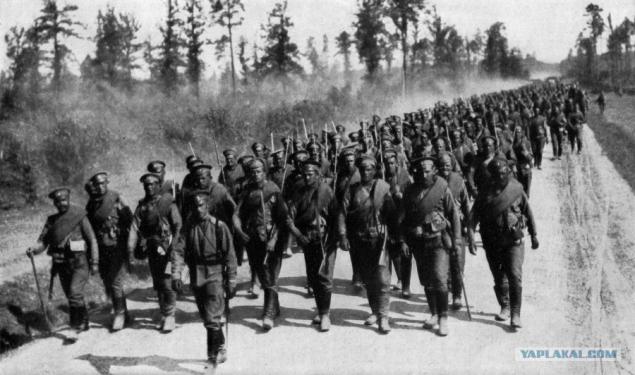
Let's begin with France.
At the beginning of World War I, the French army was equipped with only a standard cap, which did not give any protection from enemy fire. However, with the beginning of trench warfare became head injuries serious problem. Therefore, in 1915, was designed helmet protects both from shell fragments and shrapnel (which along the axis of the helmet has been set reflects the crest). The helmet was designed by Louis Auguste Army General Adrian. he went down in history as the Adrian helmet m1915. Helmet consisted of four parts: a hemispherical vault helmet visors front and rear (both with sharp edges fringed) and groove covering the vent hole and enhancing the protective properties of the helmet. As the helmet was quite effective against shrapnel, cheap and easy to manufacture, and weighed less than counterparts created in other countries by the end of the First World, it was used by almost all the troops of the French army, as well as some of the US forces, the fighting in French and Polish forces Blue Army Józef Haller. In addition, it was adopted in Belgium, Greece, Italy (including manufactured under license), the Russian Empire (and later in the Soviet Union), Japan, Luxembourg, Mexico, Morocco, Peru, Poland, Yugoslavia, and so on. D. ( Only in France was made nearly 20 million helmets). However, according to some reports, due to the fact there is no protection from bullets, these helmets were among the first pieces of ammunition, thrown by soldiers on the battlefield.
The photo of Adrian helmet.
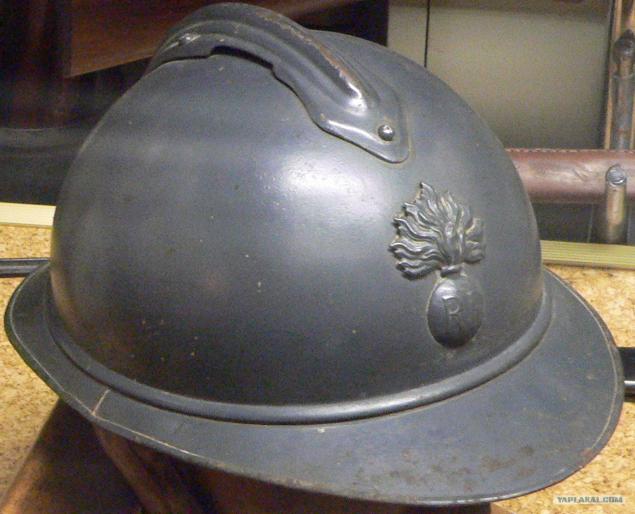
Russia.
Steel helmet for the first time in large numbers appeared in April 1916. Special teams Russian riflemen were sent to France that would fight on the Western Front. Largely outfit these brigades carried out by the French but not limited to these parts got the French Adrian helmet, the only difference was that the presence of the front emblem with the coat of arms of the Russian Empire. In mid-1916 Petersburg place orders for 2 000 000 Adrian helmets, but only 340,000 units were delivered to Russia by the end of 1916. In Russia, these helmets were known as M 1916.
In 1917, the government placed an order for the production of helmets in Finland at the factory Sollberg. M17 helmet Solberg (sorry do not know how to write or Sollberg Solberg, in different sources written in different ways) was upgraded Adrian helmet, but the Russian army these helmets so really did not get because we have started a revolution.
The photo Sollberg M17 helmet
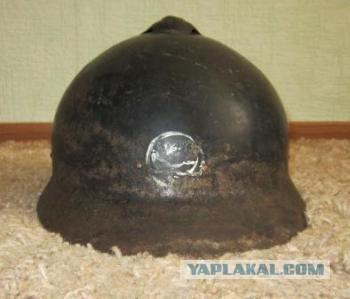
The photo The Banner Group strike force 8 army helmets Sollberg M17
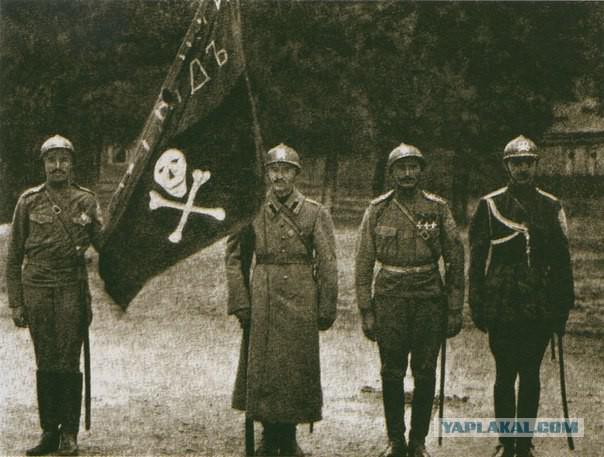
England.
In July 1915, the War Department was selected for the production of project John Leopold Brodie (John Leopold Brodie). The official name of «Brodie's Steel Helmet, War Office Pattern». Steel thickness 0, 9 mm. Weight helmet 950 painted in khaki. On the helmets are often applied emblems parts. Distributed in Commonwealth countries: Australia, South Africa, New Zealand and so on. D. And also: Portugal, USA, Norway and others. During the war, produced 7 million copies.
The photo Brodie helmet

Italy.
As I wrote above, the Italian army at the beginning of the war was provided by the French Adrian helmet. Later, the government has made attempts to establish a production of steel helmets to simplify the design. An attempt was made to add even helmets plumes of feathers ... by the way! Was an attempt to make the helmets made of aluminum (parade), but except for the parade they had nowhere application.
The photo Italian and German infantryman during the first world.
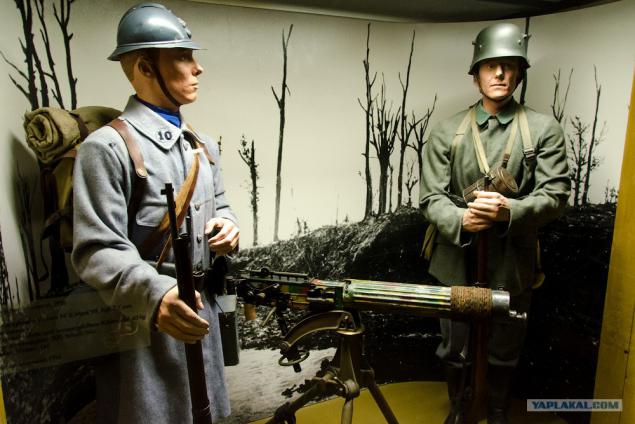
Germany.
But Germany came to the matter very, very thoroughly.
Pickelhaube.
Germany started the war with Pickelhaube (which was adopted in 1842 already.) First in Prussia, and later in other German states. The basis of the helmet was made of hardened leather with metal inserts, usually silver-plated or gold-plated (for officers). One of the features is a spike Pickelhaube helmet.
All helmets are produced for the German infantry during 1914 were made of leather, but gradually reserves skin in Germany began to be depleted and the country had to look ersatz substitutes. There are even helmets Pressed paper.
The First World has shown that this helmet is not very good, as the skin badly protected from debris and shrapnel. By the spike on the helmet gave the enemy where the soldiers and enemy snipers often dispute was shot by thorns. An attempt was made to introduce Pickelhaube with removable spikes and protective case, but the situation is not changed.
The photo Pickelhaube one of the latest versions.
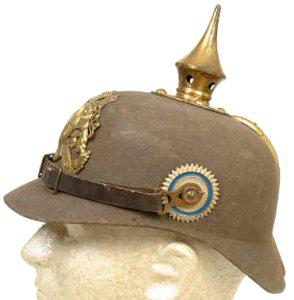
Gaede helmet.
In 1915, General Gaede commanded troops in the Vosges mountains, which is near the Swiss border. The general was surprised by the number of injuries in the head by his subordinates on a very quiet sector of the front. Designed and produced by the urban workshops his helmet.
(Here the data disagree, some sources say that the general had paid out of his pocket and gave his soldiers, but other sources say the company for the manufacture of these helmets belonged to him and very good general lobbied the purchase of these helmets army that brought him considerable income). Design feature was the fact that the general tried to make eye protection (eye!). Was released in 1500 of helmets, but with the arrival of M 16 the majority of them went to the smelter.
The photo fighter helmet Gaede

M16.
In 1915, under the direction of a military doctor Professor and Professor Friedrich Shvedra Augusta Beer began the development of a steel helmet. Examining the causes of head injuries and their cause were made various prototypes that were tested at the site. In 1916 he was admitted steel helmet M16.
The first small batch of M16 entered the troops at Verdun. There was a sharp decline in injuries to the head, which led to the mass production of the M16 and the complete exclusion Pickelhaube.
One of the features of the M16 were small horns on the helmet, which caused a lot of jokes and cartoons about the horned German soldiers (until a German soldier fighting his wife teaches him the horns, so much so famously that horn prolazili even through the helmet) by the enemies of Germany. In fact, these same horns on the helmet is the scientists was an attempt to protect soldiers in the new at the time of trench warfare. Increase the armor and helmet make suitable for everyday wear is not possible, therefore, was designed hinged armored plate which is mounted on the helmet when trench confrontations. Armored plate clung to the horns and pulls a leather strap. The whole situation was comical that helmets were produced in different sizes, and armored plate in one, therefore, to secure the armor plates on the small size helmets manufacturers increase horns. Therefore, the smaller a soldier's helmet was, the more he had horns.
The idea of armor plate was extremely unfortunate. Yes, helmet with armor plate safely withstand the hit on the range rifle bullet, but in practice, the bullet did not break through the soldier's head and broke his neck.
During the war, was released more than 7 mln.kasok, some of them fought right up to '45 ...
The photo with the M16 armor plates on the frontal part of the helmet.
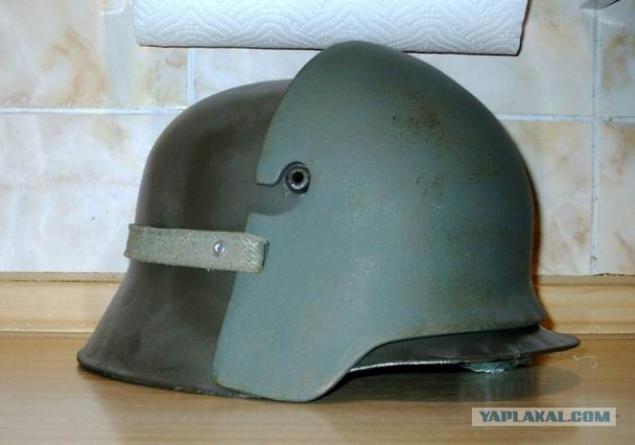
M18 Cavalry.
This helmet does not have its own symbols, but was used in the army and was "popular" names. Such as "the trooper helmet", "helmet communicator", "gunner helmet».
A distinctive feature of this helmet was that he had been removed near the ears of the "skirt", which improved audibility in a helmet and gave the ability to talk on the phone signalman without removing the helmet.
The photo M18

Turkish M18.
I beg your pardon, just could not pass this helmet.
In 1918, was created specifically for the modification of the helmet Turkish soldiers. A distinctive feature of this kaski- shortened visor, allowing the soldiers and officers forehead touching the ground during prayer.
The photo M18 Turkish version.
At this perhaps until vse.vash Haupman.

Good day, dear yapovtsy. Today I want to talk about helmets. It is difficult to imagine a modern soldier without this most helmets. I will not delve into history and recall the helmets of ancient warriors, and want to talk about helmets First World War, because in fact if helmets are almost departed into oblivion came back again and become an integral part of the equipment of a soldier.
You know, I've been thinking of the country with which to start? in most countries by the beginning of World War II were sometimes brilliant ideas. Therefore, I will first tell you about the allies, and then on the helmets triple alliance. Will be a bit of text and photos. Please do not break. I will inform you about the end, but for the impatient say that fasting is over Turkish helmet.
Warning! Megaspetsam all who do not like it, I call helmets-helmets and helmets, helmets, they say it is necessary to speak properly because they have been taught, I want to say one thing! I do not grunt, I did not teach. In my life I only wore ZS-3 and ZS-7. So if you have something to say to welcome existing and cling to the words is an empty it.
So, perhaps we will begin.

Let's begin with France.
At the beginning of World War I, the French army was equipped with only a standard cap, which did not give any protection from enemy fire. However, with the beginning of trench warfare became head injuries serious problem. Therefore, in 1915, was designed helmet protects both from shell fragments and shrapnel (which along the axis of the helmet has been set reflects the crest). The helmet was designed by Louis Auguste Army General Adrian. he went down in history as the Adrian helmet m1915. Helmet consisted of four parts: a hemispherical vault helmet visors front and rear (both with sharp edges fringed) and groove covering the vent hole and enhancing the protective properties of the helmet. As the helmet was quite effective against shrapnel, cheap and easy to manufacture, and weighed less than counterparts created in other countries by the end of the First World, it was used by almost all the troops of the French army, as well as some of the US forces, the fighting in French and Polish forces Blue Army Józef Haller. In addition, it was adopted in Belgium, Greece, Italy (including manufactured under license), the Russian Empire (and later in the Soviet Union), Japan, Luxembourg, Mexico, Morocco, Peru, Poland, Yugoslavia, and so on. D. ( Only in France was made nearly 20 million helmets). However, according to some reports, due to the fact there is no protection from bullets, these helmets were among the first pieces of ammunition, thrown by soldiers on the battlefield.
The photo of Adrian helmet.

Russia.
Steel helmet for the first time in large numbers appeared in April 1916. Special teams Russian riflemen were sent to France that would fight on the Western Front. Largely outfit these brigades carried out by the French but not limited to these parts got the French Adrian helmet, the only difference was that the presence of the front emblem with the coat of arms of the Russian Empire. In mid-1916 Petersburg place orders for 2 000 000 Adrian helmets, but only 340,000 units were delivered to Russia by the end of 1916. In Russia, these helmets were known as M 1916.
In 1917, the government placed an order for the production of helmets in Finland at the factory Sollberg. M17 helmet Solberg (sorry do not know how to write or Sollberg Solberg, in different sources written in different ways) was upgraded Adrian helmet, but the Russian army these helmets so really did not get because we have started a revolution.
The photo Sollberg M17 helmet

The photo The Banner Group strike force 8 army helmets Sollberg M17

England.
In July 1915, the War Department was selected for the production of project John Leopold Brodie (John Leopold Brodie). The official name of «Brodie's Steel Helmet, War Office Pattern». Steel thickness 0, 9 mm. Weight helmet 950 painted in khaki. On the helmets are often applied emblems parts. Distributed in Commonwealth countries: Australia, South Africa, New Zealand and so on. D. And also: Portugal, USA, Norway and others. During the war, produced 7 million copies.
The photo Brodie helmet

Italy.
As I wrote above, the Italian army at the beginning of the war was provided by the French Adrian helmet. Later, the government has made attempts to establish a production of steel helmets to simplify the design. An attempt was made to add even helmets plumes of feathers ... by the way! Was an attempt to make the helmets made of aluminum (parade), but except for the parade they had nowhere application.
The photo Italian and German infantryman during the first world.

Germany.
But Germany came to the matter very, very thoroughly.
Pickelhaube.
Germany started the war with Pickelhaube (which was adopted in 1842 already.) First in Prussia, and later in other German states. The basis of the helmet was made of hardened leather with metal inserts, usually silver-plated or gold-plated (for officers). One of the features is a spike Pickelhaube helmet.
All helmets are produced for the German infantry during 1914 were made of leather, but gradually reserves skin in Germany began to be depleted and the country had to look ersatz substitutes. There are even helmets Pressed paper.
The First World has shown that this helmet is not very good, as the skin badly protected from debris and shrapnel. By the spike on the helmet gave the enemy where the soldiers and enemy snipers often dispute was shot by thorns. An attempt was made to introduce Pickelhaube with removable spikes and protective case, but the situation is not changed.
The photo Pickelhaube one of the latest versions.

Gaede helmet.
In 1915, General Gaede commanded troops in the Vosges mountains, which is near the Swiss border. The general was surprised by the number of injuries in the head by his subordinates on a very quiet sector of the front. Designed and produced by the urban workshops his helmet.
(Here the data disagree, some sources say that the general had paid out of his pocket and gave his soldiers, but other sources say the company for the manufacture of these helmets belonged to him and very good general lobbied the purchase of these helmets army that brought him considerable income). Design feature was the fact that the general tried to make eye protection (eye!). Was released in 1500 of helmets, but with the arrival of M 16 the majority of them went to the smelter.
The photo fighter helmet Gaede

M16.
In 1915, under the direction of a military doctor Professor and Professor Friedrich Shvedra Augusta Beer began the development of a steel helmet. Examining the causes of head injuries and their cause were made various prototypes that were tested at the site. In 1916 he was admitted steel helmet M16.
The first small batch of M16 entered the troops at Verdun. There was a sharp decline in injuries to the head, which led to the mass production of the M16 and the complete exclusion Pickelhaube.
One of the features of the M16 were small horns on the helmet, which caused a lot of jokes and cartoons about the horned German soldiers (until a German soldier fighting his wife teaches him the horns, so much so famously that horn prolazili even through the helmet) by the enemies of Germany. In fact, these same horns on the helmet is the scientists was an attempt to protect soldiers in the new at the time of trench warfare. Increase the armor and helmet make suitable for everyday wear is not possible, therefore, was designed hinged armored plate which is mounted on the helmet when trench confrontations. Armored plate clung to the horns and pulls a leather strap. The whole situation was comical that helmets were produced in different sizes, and armored plate in one, therefore, to secure the armor plates on the small size helmets manufacturers increase horns. Therefore, the smaller a soldier's helmet was, the more he had horns.
The idea of armor plate was extremely unfortunate. Yes, helmet with armor plate safely withstand the hit on the range rifle bullet, but in practice, the bullet did not break through the soldier's head and broke his neck.
During the war, was released more than 7 mln.kasok, some of them fought right up to '45 ...
The photo with the M16 armor plates on the frontal part of the helmet.

M18 Cavalry.
This helmet does not have its own symbols, but was used in the army and was "popular" names. Such as "the trooper helmet", "helmet communicator", "gunner helmet».
A distinctive feature of this helmet was that he had been removed near the ears of the "skirt", which improved audibility in a helmet and gave the ability to talk on the phone signalman without removing the helmet.
The photo M18

Turkish M18.
I beg your pardon, just could not pass this helmet.
In 1918, was created specifically for the modification of the helmet Turkish soldiers. A distinctive feature of this kaski- shortened visor, allowing the soldiers and officers forehead touching the ground during prayer.
The photo M18 Turkish version.
At this perhaps until vse.vash Haupman.

Tags
See also
During World War I
Photos of the First World War
The best pilots of the First World War.
Live photos of the First World War
Things were first developed during the First World War.
Pictures of the First World War, of the pioneers autochromes
Interesting facts about the First World War
The first transformer during World War I (3 photos)
Acoustic locators during the First World War
Four-legged heroes

















